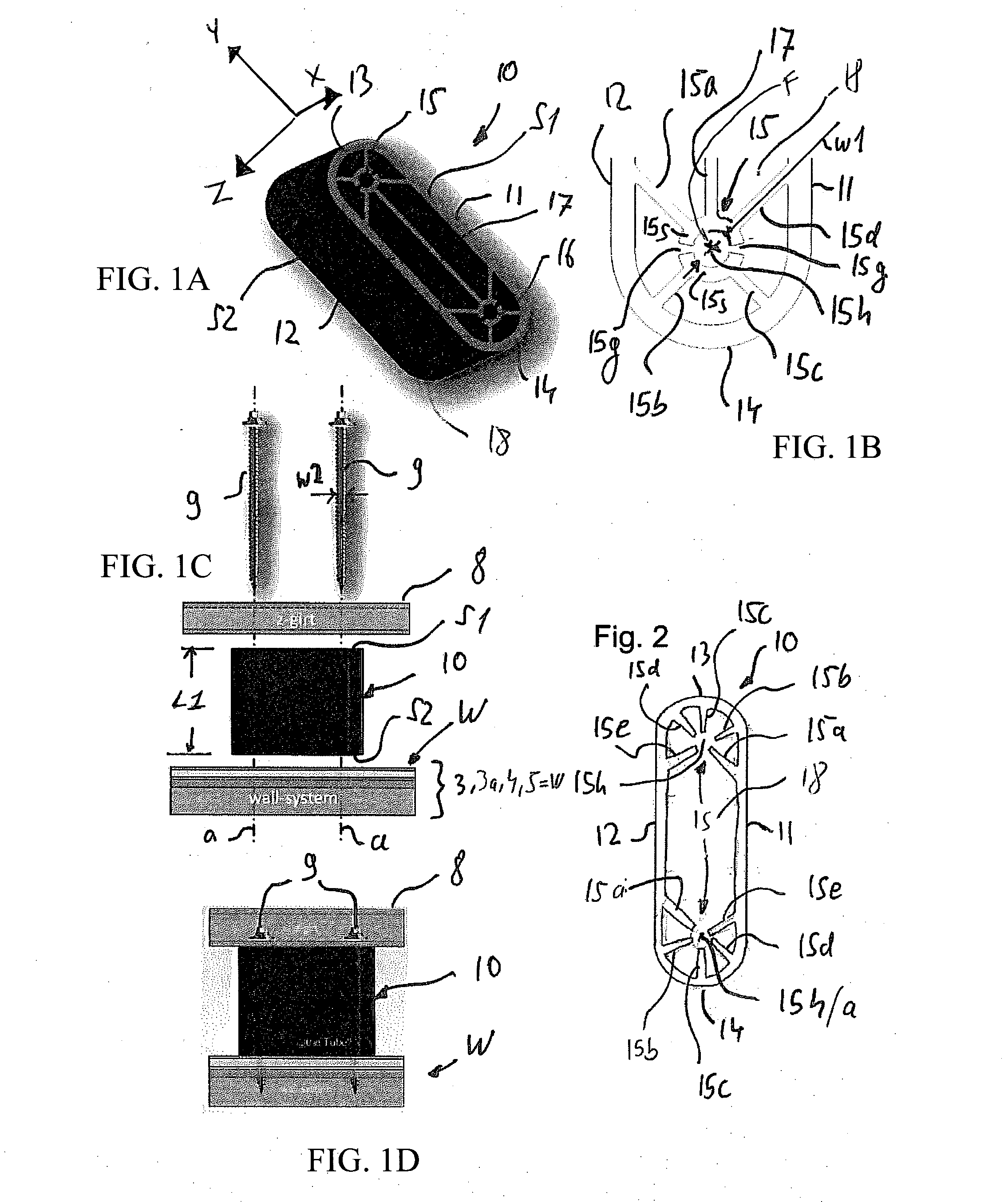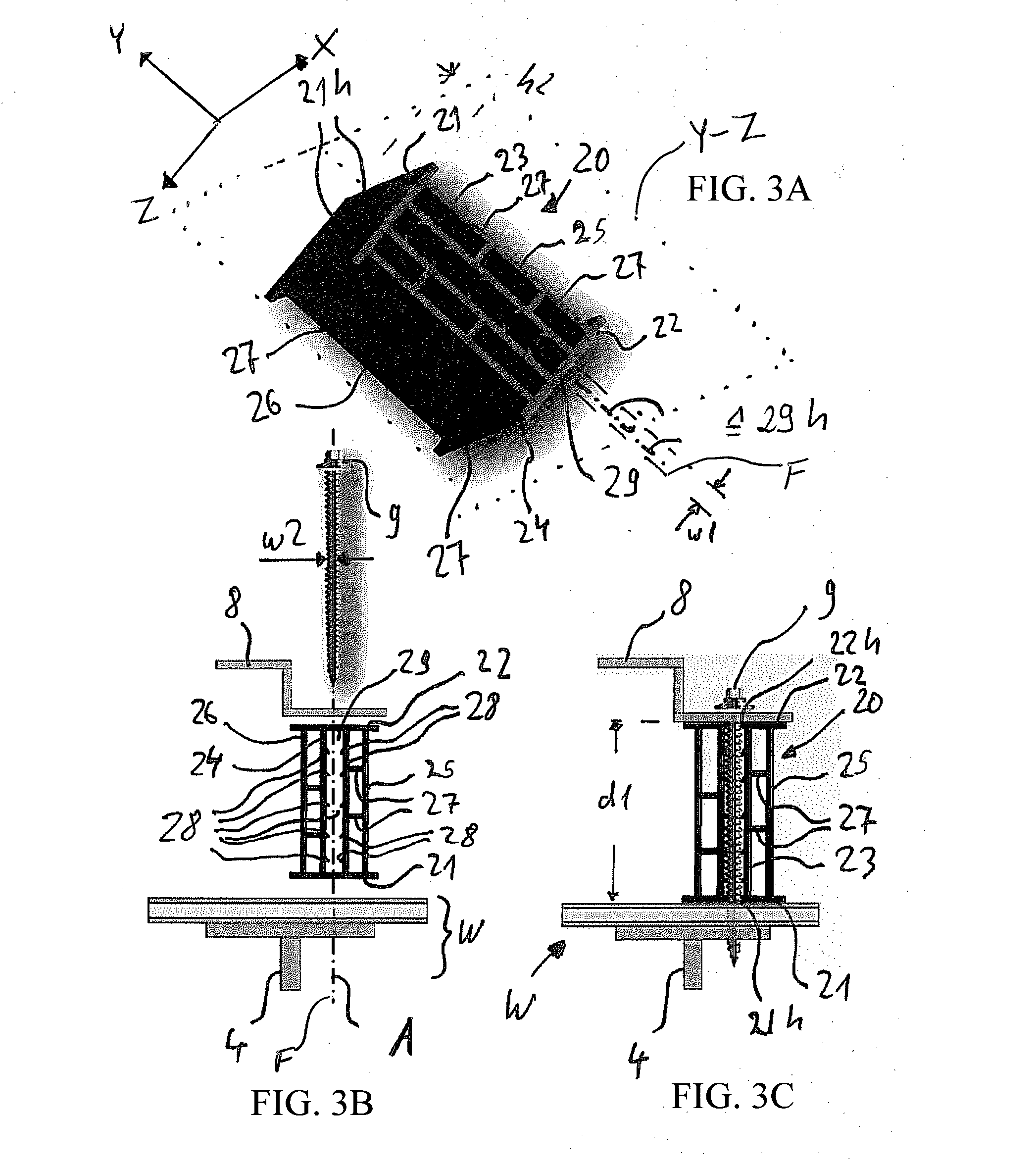Spacer for retaining cladding element on structural building element
a technology for retaining cladding and structural building elements, which is applied in the direction of building repairs, roof tools, roofing, etc., can solve the problems of poor thermal insulation properties of the assembly and defeat the purpose of providing insulation materials, and achieves the goal of achieving highly precise dimensions relatively easily, simple structure, and low tooling and extrusion costs
- Summary
- Abstract
- Description
- Claims
- Application Information
AI Technical Summary
Benefits of technology
Problems solved by technology
Method used
Image
Examples
first embodiment
[0035]FIGS. 1A and 1B show the spacer according to the present teachings and FIGS. 1C and 1D show the spacer during a mounting operation and at the conclusion thereof, respectively.
[0036]The embodiment shown in FIG. 1 can be characterized, e.g., as having a tube-like structure, in the sense that it has an at least substantially hollow interior structure with a continuous enclosing (surrounding) wall, preferably a single continuous enclosing (surrounding) exterior wall. However, while the term “tube” is normally associated with hollow cylindrical structures, as used herein, the term “tube-like” is intended to encompass a broader range of substantially hollow structures.
[0037]For example, in the present embodiment, the enclosing wall of the spacer has a substantially rectangular cross-section with rounded or curved corners / ends, e.g., a rectangular oval, which is similar in shape to a horse racing track. But, the present teachings are not particularly limited in this regard and altern...
third embodiment
[0068]The third embodiment shown in FIG. 3 includes a second set of two parallel side walls 25, 26, which are also parallel to the first set of side walls 23, 24. However, the second set of side walls 25, 26 are optional and the person of ordinary skill in the art can readily determine whether to include the second set of side walls 25, 26 in view of the loads to be carried or supported by the spacer 20 in the actual application.
[0069]In the embodiment shown in FIG. 3, the side wall 25 is disposed parallel to the side wall 23 on the side thereof opposite to the interior space 29 and is connected to the side wall 23 by two connection walls 27, which are parallel to the flange walls 21, 22 (perpendicular to the side walls 23, 25). The same applies to the other side wall 26, which is parallel to the side wall 24 and is disposed on the side thereof that is opposite to the interior space 29. The side wall 26 is also connected to the side wall 24 by two connection walls 27 that extend par...
second embodiment
[0077]However, the direction of the extrusion of the block-like embodiment does not correspond to the direction F of the fastener insertion path 29h. Instead, the extrusion direction is perpendicular to the fastener insertion path 29h. Accordingly, the spacer 20 can also be produced in an endless manner, cut into elongated bars having a length, for example, of 6 m for shipment to the customer, and then cut into shorter segments of a predetermined height h2. However, unlike in the first and second embodiment, this height h2 does not determine the spacing distance d1 between the wall structure W and the cladding element 8; rather, the height h2 determines the areas of contact with the wall structure W and the cladding element 8, respectively.
[0078]Thus, this third embodiment enables the contact area to be variable by cutting the bars into different lengths h2. However, the spacing distance d1 is not variable. On the other hand, in the first and second embodiments, the spacing distance...
PUM
 Login to View More
Login to View More Abstract
Description
Claims
Application Information
 Login to View More
Login to View More - R&D
- Intellectual Property
- Life Sciences
- Materials
- Tech Scout
- Unparalleled Data Quality
- Higher Quality Content
- 60% Fewer Hallucinations
Browse by: Latest US Patents, China's latest patents, Technical Efficacy Thesaurus, Application Domain, Technology Topic, Popular Technical Reports.
© 2025 PatSnap. All rights reserved.Legal|Privacy policy|Modern Slavery Act Transparency Statement|Sitemap|About US| Contact US: help@patsnap.com



